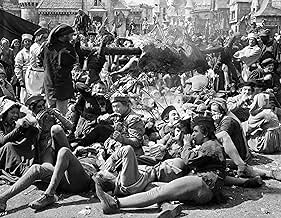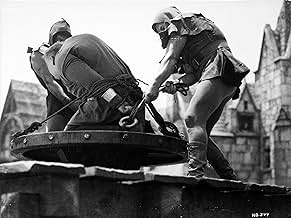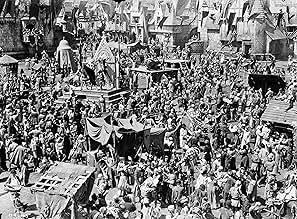IMDb रेटिंग
7.8/10
13 हज़ार
आपकी रेटिंग
अपनी भाषा में प्लॉट जोड़ेंIn 15th-century France, a gypsy girl is framed for murder by the infatuated Chief Justice, and only the deformed bellringer of Notre Dame Cathedral can save her.In 15th-century France, a gypsy girl is framed for murder by the infatuated Chief Justice, and only the deformed bellringer of Notre Dame Cathedral can save her.In 15th-century France, a gypsy girl is framed for murder by the infatuated Chief Justice, and only the deformed bellringer of Notre Dame Cathedral can save her.
- निर्देशक
- लेखक
- स्टार
- 2 ऑस्कर के लिए नामांकित
- 1 जीत और कुल 2 नामांकन
Cedric Hardwicke
- Frollo
- (as Sir Cedric Hardwicke)
Helene Reynolds
- Fleur de Lys
- (as Helene Whitney)
Minna Gombell
- Queen of Beggars
- (as Mina Gombell)
Rod La Rocque
- Phillippe
- (as Rod LaRocque)
फ़ीचर्ड समीक्षाएं
One of the great Hollywood films of 1939, this adaptation of Victor Hugo's novel is sumptuously put together, boasting a fine script, tight direction by German export William Dieterle, and a cast who fit their parts perfectly: Charles Laughton superb as the maligned Quasimodo; Maureen O'Hara in an early role as gypsy Esmeralda; Cedric Hardwicke as the pious Frollo; and Harry Davenport as the king, Louis XI.
The story is a version of Beauty and the Beast set within the confines of Notre Dame Cathedral and the dirt-strewn and prejudiced streets of Paris. Quasimodo, physically repulsive and deafened by the bells of the cathedral, nevertheless finds it in his childish heart to love the beautiful Esmeralda and to sacrifice his sanctuary for her. She however only has eyes for the dashing Gringoire (Edmond O'Brien) who she saves from the justice of the beggar thieves.
It is Laughton's performance that holds this film together - truly one of the greatest screen actors, capable of portraying pathos like no other. Contrast this film role with his Henry VIII or Captain Bligh and you begin to get an idea of his impressive range.
The story is a version of Beauty and the Beast set within the confines of Notre Dame Cathedral and the dirt-strewn and prejudiced streets of Paris. Quasimodo, physically repulsive and deafened by the bells of the cathedral, nevertheless finds it in his childish heart to love the beautiful Esmeralda and to sacrifice his sanctuary for her. She however only has eyes for the dashing Gringoire (Edmond O'Brien) who she saves from the justice of the beggar thieves.
It is Laughton's performance that holds this film together - truly one of the greatest screen actors, capable of portraying pathos like no other. Contrast this film role with his Henry VIII or Captain Bligh and you begin to get an idea of his impressive range.
Charles Laughton's boisterous portrayal of Quasimodo and Maureen O'Hara's charm as Esmerelda are two of the things that make this version of "The Hunchback of Notre Dame" a fine production that still works very well. Most of the versions of the story have been at least watchable, because the Victor Hugo novel provides so much good material to work with, much of it well-suited for cinema. This adaptation, though, is one of the best at making good use of what it offers.
It's interesting to compare this picture with the 1923 Lon Chaney version - not for the sake of ranking them, since both are fully worthy of attention in their own right, but because they offer somewhat different strengths, and because they emphasize somewhat different aspects of the story.
Chaney and Laughton are both quite effective as Quasimodo, each giving an interpretation of the character that corresponds to the actor's skills. Laughton brings out Quasimodo's feelings and perspective quite well. In this version, for example, the flogging scene is longer and more detailed, and it is one of Laughton's most effective scenes. Chaney is particularly good at reacting to the other characters and their actions. Both give the character a distinctive and memorable look.
O'Hara is also one of this adaptation's strengths. Patsy Ruth Miller was good in the Chaney version, but O'Hara has the advantage of spoken dialogue, and she makes the character of Esmerelda her own.
While the Chaney version especially emphasized the atmosphere, this one has quite a bit of action. The tumultuous climactic sequences are done quite well, and they leave a vivid impression. Overall, this is a very satisfying adaptation of the fine classic novel.
It's interesting to compare this picture with the 1923 Lon Chaney version - not for the sake of ranking them, since both are fully worthy of attention in their own right, but because they offer somewhat different strengths, and because they emphasize somewhat different aspects of the story.
Chaney and Laughton are both quite effective as Quasimodo, each giving an interpretation of the character that corresponds to the actor's skills. Laughton brings out Quasimodo's feelings and perspective quite well. In this version, for example, the flogging scene is longer and more detailed, and it is one of Laughton's most effective scenes. Chaney is particularly good at reacting to the other characters and their actions. Both give the character a distinctive and memorable look.
O'Hara is also one of this adaptation's strengths. Patsy Ruth Miller was good in the Chaney version, but O'Hara has the advantage of spoken dialogue, and she makes the character of Esmerelda her own.
While the Chaney version especially emphasized the atmosphere, this one has quite a bit of action. The tumultuous climactic sequences are done quite well, and they leave a vivid impression. Overall, this is a very satisfying adaptation of the fine classic novel.
A sweeping claim? Perhaps. But despite the presence in Hollywood over sixty subsequent years of Ford, Wyler, Kubrick, Coppola, Scorsese et al, The Hunchback of Notre Dame remains as fresh, as emotionally resonant and yes as powerfully artistic as the day it was made. What constitutes 'art' is of course a personal matter, just as the Breughel-like compositions of Hunchback might be as mystifying to someone whose favourite film is A Clockwork Orange (Lichtenstein?). But what makes Hunchback so satisfying as art is precisely that its makers didn't set out with art in mind. Dieterle and his co-creators embarked on the project with the aim of telling a great yarn, making it look authentic, and above all ENTERTAINING the audience. It is to this end that the Grand Guignol excesses of the novel were trimmed or altered, and the Hollywood bittersweet ending imposed. Audiences filed out with their Kleenex in hand having witnessed a three-ring circus of a movie, then went home to read the war-soaked newspapers.
Virtually every frame of this movie could be taken in isolation, made into a poster and hung on a wall. Examples include Gringoire cradling the dying Clopin as a rivulet of lead trickles past in the background, the voyeuristic eye of Quasimodo peering through fence palings at the dancing Esmeralda - I could go on and on. And pervading it all is the magnificent score of Alfred Newman, surely his finest ever.
Rather than sing its obvious praises, the film can simply speak for itself. As narrative, as character, as cinema craft, it is totally successful throughout. The Hunchback of Notre Dame is my favourite film of all time, bar none. Ten out of ten
Virtually every frame of this movie could be taken in isolation, made into a poster and hung on a wall. Examples include Gringoire cradling the dying Clopin as a rivulet of lead trickles past in the background, the voyeuristic eye of Quasimodo peering through fence palings at the dancing Esmeralda - I could go on and on. And pervading it all is the magnificent score of Alfred Newman, surely his finest ever.
Rather than sing its obvious praises, the film can simply speak for itself. As narrative, as character, as cinema craft, it is totally successful throughout. The Hunchback of Notre Dame is my favourite film of all time, bar none. Ten out of ten
The 1939 version of Hugo's classic tale of beauty and the beast is definitely the definitive. It features a great performance by Charles Laughton as Quasimodo, dubbed the Hunchback of Notre Dame, because of his twisted appearance. It's pointless for me to talk about the story, because I'm sure everyone is familiar with it, it's one of the best works of literature ever produced. Id' just like to say this is a beautiful film about a beautiful person, cursed to be considered an out cast, "the king of fools"... Films like this and David Lynch's The Elephant Man really make you think a little differently about this so-called "beautiful" world. The Hunchback of Notre Dame has something for everyone to enjoy.
10llltdesq
The best of the many versions of The Hunchback of Notre Dame, for my money, is this one, although Lon Chaney's is a close second. Despite a Hollywood tendancy to change the novel's ending so as not to depress the cash customers (although, pray tell, if you're going to change the ending, why does no one ever see Quasimodo sailing off to Tahiti with the girl? Rule # 1: strong, handsome poets beat out disfigured cripples every time, even if they're heroes. This is more true in real life than in the movies. Take my word for this, I know from painful experience *sigh*)
Charles Laughton is exceptional and Maureen O'Hara would make any man swoon and is perfect for the part of Esmerelda. The support includes the usual suspects-Thomas Mitchell, Harry Davenport and many other familiar character actors. Strike up the band and start the parade. Thunderous applause. Most highly recommended.
Charles Laughton is exceptional and Maureen O'Hara would make any man swoon and is perfect for the part of Esmerelda. The support includes the usual suspects-Thomas Mitchell, Harry Davenport and many other familiar character actors. Strike up the band and start the parade. Thunderous applause. Most highly recommended.
क्या आपको पता है
- ट्रिवियाFor the scene in which Quasimodo is whipped, Charles Laughton instructed an assistant director to twist his ankle outside of camera range so he would really be in pain. Even through the heavy hump and rubber body suit, he felt every lash and often came home badly bruised. Before the 16th take, director William Dieterle whispered to him, "Now, Charles, listen to me. Let's do it one more time, but this time I want you . . . I want you to suffer." According to Laughton's wife, Elsa Lanchester, the actor never forgave him for that.
- गूफ़The cathedral is shown as having a full flight of steps up to the front doors. Notre Dame has always been more or less level with the square (le Parvis).
- भाव
[Last lines]
Quasimodo, the bell-ringer: [to one of the stone gargoyles] Why was I not made of stone - like thee?
- क्रेज़ी क्रेडिटPROLOGUE: "With the end of the 15th Century, the Middle Ages came to a close. Europe began to see great changes. France, ravaged by a hundred years of war, at last found peace. The people under Louis XI felt free to hope again --- to dream of progress. But superstition and prejudice often stood in the way, seeking to crush the adventurous spirit of man."
- इसके अलावा अन्य वर्जनAlso available in a computer colorized version.
- साउंडट्रैकAve Maria
(1572) (uncredited)
Music by Tomás Luis de Victoria
Sung by mixed chorus during opening credits
टॉप पसंद
रेटिंग देने के लिए साइन-इन करें और वैयक्तिकृत सुझावों के लिए वॉचलिस्ट करें
विवरण
- रिलीज़ की तारीख़
- कंट्री ऑफ़ ओरिजिन
- आधिकारिक साइट
- भाषा
- इस रूप में भी जाना जाता है
- Victor Hugo's Immortal Classic The Hunchback of Notre Dame
- फ़िल्माने की जगहें
- उत्पादन कंपनी
- IMDbPro पर और कंपनी क्रेडिट देखें
बॉक्स ऑफ़िस
- बजट
- $18,00,000(अनुमानित)
- चलने की अवधि1 घंटा 56 मिनट
- रंग
- पक्ष अनुपात
- 1.37 : 1
इस पेज में योगदान दें
किसी बदलाव का सुझाव दें या अनुपलब्ध कॉन्टेंट जोड़ें

टॉप गैप
By what name was The Hunchback of Notre Dame (1939) officially released in India in English?
जवाब






































